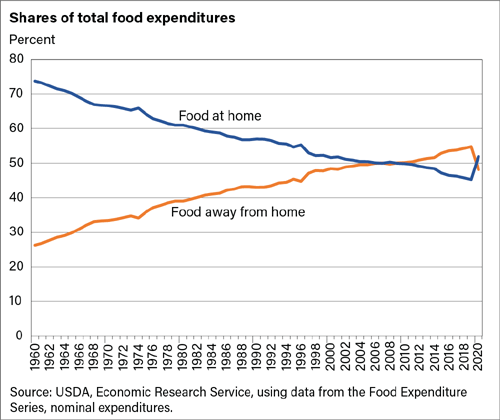In the U.S. food is sold in a variety of ways. Consumers spend their food dollar at mega-companies like Walmart and Amazon to small restaurants and farmer markets. Generally speaking, most food in the U.S. is sold through one of two channels: food retail or foodservice. According to the USDA’s Economic Research Service, the foodservice and food retailing channels together supplied about $1.69 trillion worth of food to the economy in 2020.
The primary difference between a food retailing and foodservice operation is that retailers sell food products to shoppers (who usually use the products to prepare their own meals at home) while food service operators prepare and sell meals to their customers. Of course many foodservice segments – including a lot of restaurants – are also selling entertainment and convenience but the food is still central to success.
One way that the USDA categorizes the industry is by tracking whether expenditures are for “food at home” or “food away from home”. From the 1960’s through the 1990’s expenditures in the food at home category were always greater than those in the food away from home category and in fact the former dwarfed the latter throughout the 1960’s.

Then the trend started to change in the mid-2000’s as the gap closed and from about 2008 onwards more than 50% of food sold in the country was in the “food away from home” category. But in 2020 the share of “food at home” expenditures was 51.9 percent and “food away from home” was 48.1 percent. This was the first year that sales attributed to this latter category fell below 50% since 2008. The change was due to a 16.9% decline in the foodservice sector primarily due to the Covid-19 pandemic.
However you look at it, Americans like to dine out a lot and until 2019 more preferred this to cooking at home. It’s unclear whether that trend will return after the pandemic is resolved.
Helpful Resources:

